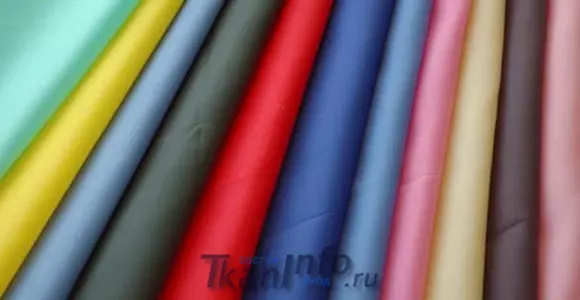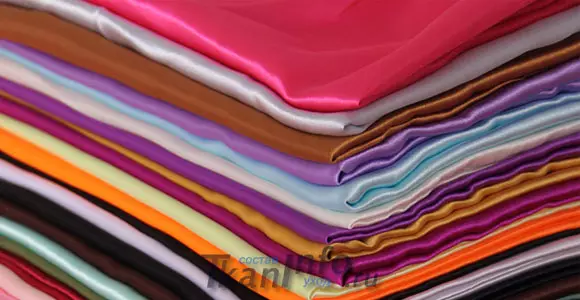Modern lining fabric is extremely diverse. It is used for sewing clothes, curtains, accessories. In order for the choice to be correct, you need to know the characteristics and properties, as well as the features of use, description and species of a particular material.
Purpose of lining

Lining materials perform the following main functions:
- hide off out;
- Protect the main material;
- absorb moisture.
They are made from natural or artificial fiber. The choice is often depends on the clothes (for example, skirts) to which the lining fabric is required.
Good lining materials include those species in which the properties include such properties as:
- lack of deformation;
- Wetting is not accompanied by shamelessness.
The fabric lining should differ density (for high-quality seam masking). A mesh fabric also comes on the lining.
Varieties of lining materials
The following types of lining fabrics are distinguished:
- chiffon;
- satin;
- atlas;
- Taffeta;
- cotton lining fabrics;
- viscose;
- polyester;
- Step fabric.
Widespread Lining Atlas . Its properties - density, smoothness, it perfectly retains the form and does not wear out. Perfect for lining in a coat, also used in a haberdashea (as a lining fabric for bags, wallets, gloves). It is suitable for sewing curtains.
Chiffon - Light and thin matter from tight twisted threads. It is perfect for skirts, dresses, blouses, curtains.
Beginner seamaries are better not to take a silk chiffon for a product with a difficult fashion. It is also worth considering that, since the chiffon is transparent, the seams should be very neat.
Viscose - Soft material that is well slips and is inexpensive, that is, perfect for lining. By the way, a high-quality lining may contain a cotton or polyester in addition to viscose fiber. Viscose is most like cotton. It is not intended to be charged with static electricity. It is used in many sewing products (for clothes and curtains).
Article on the topic: Patchwork "Cubes" blanket in the technique of Patchwork
Description Satina Profitably distinguishes it from other materials. It is heavier and thicker than the rest of the lining matter. Smooth, drop-down satin has a rich shiny surface. These properties allow you to use it for lining expensive fur coats and bags. The roll of fabric stands on weekly, so it does not suit the curtain.
Taffetta (Taffeta) - Lining matter, used for sewing dresses or skirts, since its properties are great for sewing the lower skirts. The material is soft, like cotton, and does not accumulate static electricity. The density of the tuffette web is denoted by the letter T. This value reports the total amount of thread used in width and length in production. Light tuffetta is suitable for both dresses or skirts and curtains. More hard taffeta is used to give the shape of the product.

Polyester - A very strong type of synthetics used in most sewing products (often as a mesh cloth). Polyester is very durable, however, it is not hygroscopic, and therefore is not suitable for hot weather (for summer clothes it is better to use cotton). The grid of the material is also durable, and what is important, it is very cheap. Polyester is perfectly suitable for the lining of the outerwear, use it in a haberdashea, and for sewing curtains.
Sept fabric It is performed using modern equipment that allows you to connect to 4 materials simultaneously. Quilted matter, as a rule, is used to sewing the outerwear, covered, pillows, bags, furniture upholstery, etc.
We sew from lining
The modern market offers a fairly extensive range of lining fabrics. Description of lining materials determines their important role in sewing clothes, and many of its views also participate in the production of accessories, goods of haberdashery, etc. - From the skirt to the curtains.How to sew a lining for skirt (video):
Article on the topic: Mosaic from egg shell do it yourself: master class with photos and video
The main feature of the lining materials is their properties of moisture absorption (like, for example, viscose or cotton). So, viscose is perfect for summer clothes due to its high hygroscopicity.
Polyester is very durable, even if it is a mesh tissue, at the same time, the grid is not hygroscopic. But for demi-season clothes, it is good.
Lining silk and chiffon are very attractive, but they are not recommended for the manufacture of lining. These materials are not so durable and enduring like viscose and they will remain the stains of sweat.
Mesh fabric (large and small mesh) will create magnificent skirts and ballet packs, as well as beach bags and so on. The mesh tissue is popular, as the grid has a rigid structure and perfectly fixes the form of cut parts.
The experienced seamstress knows that the grid, like a chiffon, is able to create certain difficulties when working with it, overcoming only the skill.
And finally, the quilted fabric lining is an excellent insulation of winter clothes.
Rules for choosing matter
There are some rules that need to be considered by choosing a lining material, especially when buying wholesale (cloth in rolls).
Selected types of lining material must be thinner than the main fabric of the product and have a smooth surface for easy slipping when contacting other things.
The main characteristic of synthetic, which makes it better than the cotton is that it is withstanding heavy loads. Also, the grid saves its appearance for a long time.
Description of the color gamut of the lining materials is incredible: the rolls are hiding a variety of patterns and many shades. The lining color must match the shade of the main matter, even if it is a mesh fabric. The fabric lining is obliged to be quite dark so that the elements of the inside were not visible.
Such an indispensable part of most types of clothing, as lining, may be the cause and even the key to the successful result of its manufacture.
Article on the topic: Peacock from bottles with your own hands: Master class with step-by-step instructions
